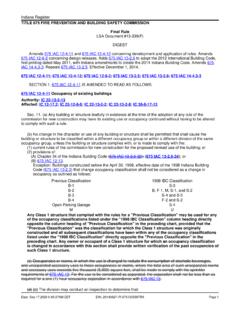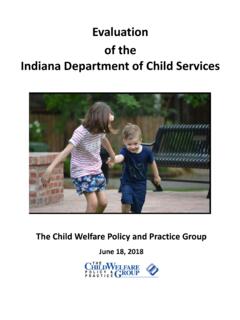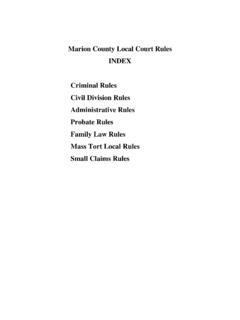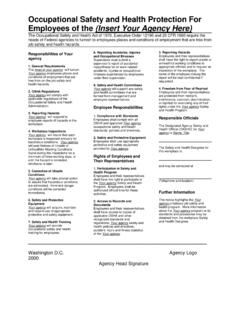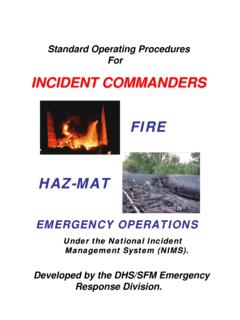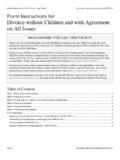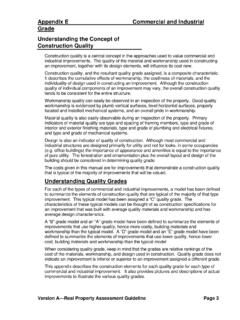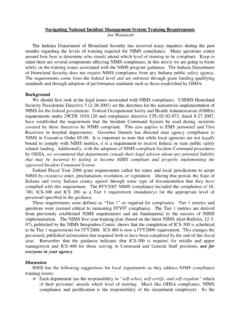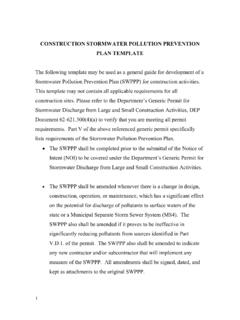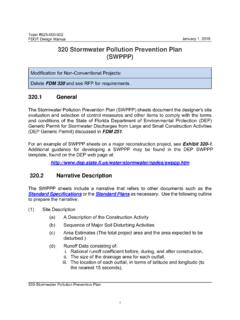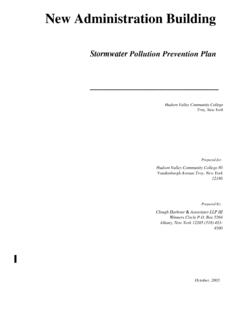Transcription of Storm Water Pollution Prevention Plan - in.gov
1 CHAPTER October 2007 Chapter 5 1 Storm Water Pollution Prevention plan Storm Water Pollution Prevention plan .. 3 Storm Water Pollution Prevention plan Development .. 7 Development of a Construction Sequence Schedule .. 39 5 This page was intentionally left blank. October 2007 Chapter 5 3 Storm Water Pollution Prevention plan S ite designers/planners and engineers typically pay very close attention to all phases of a construction project. However, the same attention is not always given to Storm Water man-agement. In fact, it is often overlooked. This section of the Storm Water manual outlines and describes a recommended step-by-step process for developing a Storm Water Pollution Prevention plan . It is intended as a guide and procedures are written in general terms to be applicable to all types of projects.
2 Site planners and regulatory authorities are urged to become familiar with the contents of this section of the manual. Once the site designer has completed the initial site assessment, planning, and design process, he or she can begin developing a set of detailed construction plans for the project. Construction plans are a blueprint for the project site. They identify resource issues; describe operational procedures; provide information in regard to project design and layout; identify areas of clearing, grading, and construction limits; and provide information in regard to the installation and maintenance of in-frastructure. The content of a construction plan is described in more detail in Chapter 3. One very important element of a construction plan is a Storm Water Pollution Prevention plan . A Storm Water Pollution Prevention plan is a working document that serves as a blueprint and prin-cipal site reference for the location, design specifications, installation criteria, construction schedule, and maintenance of all Storm Water quality measures.
3 The plan should be part of the general construction plan and not a separate document because all activities that occur on a pro-ject site are interrelated. Changes to one or more aspects of the construction plan can drastically affect elements of the Storm Water Pollution Prevention plan and vise versa. The purpose of a Storm Water Pollution Prevention plan is to establish which Storm Water quality measures will be used to minimize the discharge of pollutants from the project site. Selection of Storm Water quality measures should focus on the pollutants that are associated with the con-struction phase of the project as well as the reduction of the pollutants that will be associated with the final post-construction land use. In order to choose the appropriate measures, the plan designer should have an understanding of the project site, pollutants associated with construc-tion and the intended land use, and the sources that generate the pollutants.
4 Chapter 3 provides a summary of items that should be included in Storm Water Pollution pre-vention plans. However, it is important to recognize that the content of the Storm Water pollu-tion Prevention plan may vary from one regulating entity to the next because of differences in local ordinances and regulations. Therefore, plan designers should become familiar with the requirements and expectations of each entity having regulatory authority over the project. As noted above, a Storm Water Pollution Prevention plan identifies Storm Water quality measures that will be used to minimize the discharge of pollutants. Storm Water Pollution Prevention plan drawings should identify where each Storm Water quality measure is located in the landscape; provide construction details, dimensions, and design specifications for each measure; and pro-vide instructions for the proper installation and maintenance of each measure.
5 Information and drawings provided for each Storm Water quality measure should be clear, concise, and contain enough detail so that on-site contractors and personnel can install the measures according to 4 Chapter 5 October 2007 Storm Water Pollution Prevention plan accepted industry standards and specifications. Chapters 7 and 8 of this manual provide detailed information in regard to proper installation and maintenance of a variety of Storm Water quality measures. Proper incorporation of this information into construction plans and, in particular, the Storm Water Pollution Prevention plan will assist site designers in addressing the discharge of pollutants associated with construction activities and post-construction land uses. A very important aspect of Storm Water Pollution Prevention plans is the schedule for imple-mentation of each Storm Water quality measure.
6 Measures will not be effective if they are not installed at appropriate times during the construction process. Most measures should be in-stalled before grading and land disturbance is initiated on active areas of the project site. To meet this objective, Storm Water Pollution Prevention plans should contain a construction se-quence schedule component. Construction sequence schedules are a critical element of Storm Water Pollution Prevention plans. The sequence of construction is not necessarily a specific date when each Storm Water quality measure will be implemented, but rather a description of when each measure will be in-stalled in relation to grading and land-disturbing activities. Construction sequencing is time sen-sitive and requires planning and coordination between all individuals involved with the con-struction project.
7 The Development of a Construction Sequence Schedule section in Chapter 5 provides insight and guidance into the development of a construction sequence schedule. Another key element of a Storm Water Pollution Prevention plan is a quality assurance plan . Quality assurance plans provide guidance and establish procedures for monitoring the construc-tion site and inspecting Storm Water measures to ensure they are maintained and functioning properly. The Developing and Implementing a Quality Assurance Program in Chapter 6 pro-vides an in-depth explanation and insight into developing and implementing a quality assurance plan . In addition to the above, Indiana s Storm Water rule for runoff associated with construction ac-tivity, found in the Indiana Administrative Code under Title 327, Article 15, Chapter 5 (327 IAC 15-5), has a requirement that Storm Water measures be inspected by the end of the next business day following each measurable Storm event (defined as a precipitation event that re-sults in total measured precipitation accumulation equal to, or greater than, inch of rainfall) and at a minimum of one time per week.
8 Some local ordinances may require more frequent in-spections than those required in 327 IAC 15-5. Inspection frequency intervals and maintenance criteria are unique to every Storm Water quality measure. Inspection frequencies are generally based on the overall performance of the measure. Some measures require daily inspections whereas others may require, at a minimum, weekly inspections. Each Storm Water quality measure contained in this manual has been assigned an inspection frequency. To meet regulatory requirements and Storm Water quality measure design standards and specifi-cations, a quality assurance plan should identify an inspection schedule for each measure identi-fied in the Storm Water Pollution Prevention plan . October 2007 Chapter 5 5 Storm Water Pollution Prevention plan There are several valuable resources, including individuals knowledgeable about Storm Water issues and erosion and sediment control, which can be utilized when developing a Storm Water Pollution Prevention plan .
9 Resource information and technical assistance is available from Indi-ana s local soil and Water conservation districts, the Indiana Department of Natural Resources, the Indiana Department of Environmental Management, the Department of Agriculture s Natural Resources Conservation Service, and city or county engineering staffs. Private environ-mental and engineering firms are also a valuable resource. This page was intentionally left blank. Storm Water Pollution Prevention plan DEVELOPMENT October 2007 Chapter 5 7 U p to this point, the site designer has conducted a site assessment and data collection proc-ess, analyzed the data, and begun to formulate an overall site design and layout of the pro-ject. Using the existing project site data and information that has already been collected and analyzed, the project planning principles in Chapter 4 of this manual, and the construction plans that have been developed to this point, the site designer can now begin to develop a Storm Water Pollution Prevention plan .
10 The goal of any project is to manage Storm Water runoff and minimize the off-site discharge of pollutants. During the construction phase the focus is on minimizing erosion and sedimentation. However, there are other potential pollutants associated with construction. These pollutants in-clude but are not limited to fuel and construction waste. Appropriate project management and Storm Water quality measures will need to be implemented to minimize potential off-site pollut-ant discharges and to reduce the potential impact these pollutants may have on soil and Water quality. In regard to post-construction land uses, the focus should be on the reduction of pollut-ants generated from the type of land use and minimizing the discharge and impacts of Storm wa-ter runoff pollutants to receiving waters.
